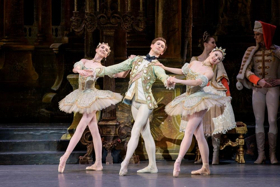Boston Ballet Presents THE SLEEPING BEAUTY

Boston Ballet presents the coming-of-age fairytale The Sleeping Beauty by Marius Petipa with additional choreography by Sir Frederick Ashton. Hailed as one of the Company's trademark works, this quintessential production features soaring music by Peter Ilyich Tchaikovsky and sumptuous sets and costumes by Emmy Award-winning designer David Walker. The Sleeping Beauty runs May 11-19, 2018, at the Boston Opera House.
"This is my favorite production of The Sleeping Beauty, and I am excited to share it with Boston audiences again. It is a fantastic introduction for the first-time ballet goer, as well as a true pleasure for connoisseurs," said Artistic Director Mikko Nissinen. "The Sleeping Beauty is ingrained in ballet history, and I am proud that Boston Ballet continues this legacy. The tradition, emotion, and atmosphere created by the superb dancing, costumes, and sets have made audiences fall in love with this beloved story again and again."
This spring, Company dancers will be tasked with adding their fresh takes on The Sleeping Beauty's many iconic and technically challenging roles, including Aurora, Carabosse, and the Lilac Fairy, among others. Ballet Master and former Principal Dancer Larissa Ponomarenko performed Aurora in Boston Ballet's previous performances of The Sleeping Beauty and has been coaching Company dancers in this role and several others.
Guest conductor Ming Luke will lead the Boston Ballet Orchestra for all five performances of Tchaikovsky's magnificent score. Luke returns to Boston Ballet after making his debut in 2016 during performances of Mikko Nissinen's The Nutcracker. He is also the principal guest conductor for San Francisco Ballet and has worked with ensembles worldwide, including Bolshoi Orchestra, Houston Symphony, Birmingham Royal, Kennedy Center Opera Orchestra, and New York City Ballet Orchestra, among others.
Marius Petipa (1818-1910), considered the "father of classical ballet," danced and choreographed for the Mariinsky Theatre in St. Petersburg, Russia for nearly 60 years. Petipa's ballets showcased the corps de ballet, which had previously only been used as an ornamental frame for solos. He also restructured the classical pas de deux into three sections: the adagio, the male and female solo variations, and the coda; some of his finest pas de deux are on display in The Sleeping Beauty.
Sir Frederick Ashton (1904-1988) became resident choreographer of The Royal Ballet in 1938; he succeeded Ninette de Valois as director in 1963 and retired in 1970. Ashton made his choreographic debut in 1926. He is widely regarded as one of the most influential dance figures of the 20th century and his choreography developed a signature English style.
Boston Ballet premiered the Ninette de Valois production of Petipa's The Sleeping Beauty in 2005 and has subsequently performed it in 2009, 2013, and 2017. Following last season's performances, Alastair Macaulay, Chief Dance Critic of The New York Times, praised Boston Ballet's production of The Sleeping Beauty as one of "the world's best."
All performances of The Sleeping Beauty take place at the Boston Opera House
(539 Washington Street, Boston, MA 02111):
Photo Credit: Liza Voll Photography, courtesy of Boston Ballet
Comments
Videos

